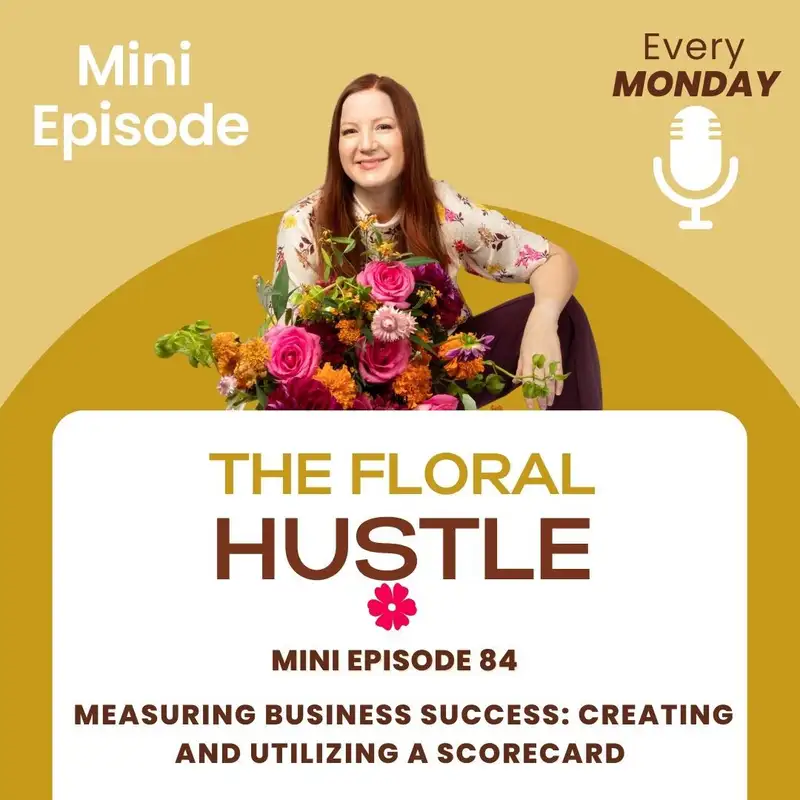Measuring Business Success: Creating and Utilizing a Scorecard - Mini Episode
📍
Hello, our friend, this is Jen, and you are listening to the floral hustle podcast on this week's Minnesota. We're going to talk about like a way you can actually tell if you're winning in your business. And that is with a scorecard. A scorecard seems fundamentally like something like, God, do I have to do a report?
Like, are we in school? Are we doing a book report? But, how do you measure progress with no metrics? So, this scorecard. is something that you can easily set up and measure the key indicators of what you are putting effort in. Because if you're putting effort in and getting no results, we either need to rethink the strategy, we need to do something different, Or, we need to start seeing if there's incremental growth because that is often where the secret lies.
Incremental growth is inching you towards your goals. And often what happens with, I see with coaching clients, with just, I mean, working out, eating healthy, you don't see those immediate like holy shit results. And so you're out. I'm out. I'm out. I'm out. It's not happening. It's not working. You haven't done it long enough to see if it actually works.
Because nothing is an overnight success. Often, like with weight loss, it takes a long time for you to actually get to a point where this is, you know, you're like, Ooh, I, you know, like my clothes are fitting better. My whatever. or that you've been going to bed early. Like you don't immediately feel like a new human the next day you go to bed early.
You need to do something continuously an inch towards your goals to be able to tell if it is making a difference. So what are some key metrics that you can actually monitor in your business? Social media. That is often one where people are like, nothing is working. You need to actually monitor. Have you grown 10 followers?
100 followers? Have you gone backwards? What has your engagement been like? How many times have you actually posted? Things that are your input, and what your expectations or hope is, that should be monitored. So, the amount of times that you post. If you're trying to grow followers, the number of followers that you currently have.
Then, if you want to even do this once a month, you will at least have some type of metric to look back at. So, followers, maybe interactions, likes, reach. Any of those social media metrics that really like when you see them and it doesn't look stupendous, you're like, yeah, that sucks. Like that is something you should be monitoring.
If you're putting effort behind it, you should be monitoring it. Profile views, uh, when, um, like clicks, any of those things you should be monitoring. Next thing, your website. Often, um, For one, like website metrics are overwhelming. People don't understand them. They don't get it. You need to actually have some fundamental understanding to know if your website is working for you and to know if your marketing efforts are supporting that energy.
So, unique visitors, repeat visitors, visits in general. Page views, what your bounce rate is, those are key metrics that I think are truly important for you understanding what is working as far as marketing. If your website is working, if you're getting no one to your website, then we know something else isn't working.
But if they're getting to your website and you have an 80 percent bounce rate on your homepage, your homepage is not laying out the path for that customer. Or you're not getting the right traffic that knows what's going to happen when they get to your website. So understanding fundamentally what's going to happen when somebody gets there, that's clearly laid out.
In our other business, we had some ads that we ran on Facebook. They had this adorable dog on it. Cause it's a dog products business that was in a bubble bath. Like we sold bath products or we do sell bath products and see the energy behind that. Because my like heart isn't in that business that even the wording is coming out to support that.
Isn't that fascinating? But, like cute adorable ad, no conversions. No conversions on this because it wasn't like selling the end result like that we are wanting to sell our bath products. So we got lots of clicks, but no conversions because people didn't really know what to expect when they clicked on the ad.
You've probably had that same experience in ads yourself and you get there and you're like, why did it bring me here? That is bounce. You leave that website. You're out of there because this isn't what I expected. This isn't what I signed up for and so you're gone. So if you are running into this isn't, Like, you're getting this high bounce rate, something along the lines is not paying off correctly in your website.
So it's definitely something to work at. But other metrics, like how many, um, lead forms that you had, how many people actually put in, um, their information, like, and then you reach out to them and then respond it. Like, that is another metric you could be tracking, not from like a. If you have HoneyBook, it's going to help you, you know, track that regardless.
But if you don't, you can just have a spreadsheet. This is how many leads that I got. This is how many people responded when I sent them communication. This is how many people that I got a appointment with, or I got to an actual consultation. This is how many people that I got to an estimate, and a full proposal, and this is how many I closed.
So then you have a closing percentage. So this is another metric for you to track. If you close 100 percent of the people that you, you meet with, Your prices might be too cheap. There's something going on, and I know everybody be like, that's wonderful! It might not be, because you might not be charging your worth.
You are undervaluing, underselling yourself, so it's just easy to get a yes. If I'm getting too many yeses, I know it's time to raise my prices. If, for some reason, you're not getting any, There could be some reasons like is your proposal really speaking to you in position you as an expert. Did your consultation position you as an expert?
Um, did you gel with that person or is your sales process kind of broken or where is the breakdown so you can figure out, okay, I'm getting leads. So we have the right people coming to my website, but I'm not getting people to respond to my emails. My email is probably not great. My response email. I need to look at that because it is not inviting me people in to my ecosystem further than that.
Then let's just say we're getting to the consultation and then like people never responded or came to your appointment. So what's dropping off there? Or you got all the way to giving them a proposal and then they ghosted you. What happened along the way that is making them ghost you? Usually, I think it's some pricing transparency and people having some general clue or you took too freaking long to get them proposals and they're out.
So there are metrics you can start to dive into and really understand if the things in your business are working. If you are spending an abundant amount of time, one great thing is to look at your revenue bucket. This was really eye opening in the Floral CEO Mastermind because we went in and we were like, okay, like one person had five different revenue buckets and they really were going to go like all in on this one revenue bucket because they're like super like thinking that this is the path.
Their revenue was 10 percent of their overall revenue was in that bucket and they were just going to go balls out and spend. You know, 50 percent effort to get that to grow. That is not their low hanging fruit. But unless you back up and have a scorecard to know what things look like, then it's really hard to tell what is being successful.
So go in and even audit last year. What percentage came from weddings? What percentage came from daily deliveries? What percentage came from workshops? What percentage came from corporate events? What percentage came from, I don't know if you do pop ups, um, stem bars, whatever. Like, track those things so that you know, I am putting a ton of energy into this thing that doesn't produce money.
I need to look at this. Or, you know what? I am working really, really hard on this category in my business, and it's the lowest revenue bucket. Hmm. That's not good. Maybe we need to re evaluate that. So then you can step back and re evaluate. Yes, that is not working. Um, I either A, need to change something on my pricing on my workshops.
I need to, like, something needs to be set up different. And then when you kind of had that dialed in, that's when you know. Okay. Like, I'm going to try to tweak and optimize. So when you're in this growth phase, you're just trying to figure out what works, period. But when you've been in business for a little while, you have some revenue, it is now time to optimize and amplify.
Optimize where you're spending your time. Amplify where you're making your money. And when you optimize and amplify, when you're at this. A little bit past like I'm beginning my business, that is when you start making serious money. I know that a la carte flowers to me is not my biggest revenue bucket, but it's one that takes the least amount of energy from me.
I know that workshops for me from an educational standpoint, those workshops are very, very intensive and I need to optimize. the revenue from that, of course, because of all the expenses that I incur when I do a workshop. So like I'm looking at that, okay, what is working, what is not working and what is sort of working and how can I make it even better?
So optimize and amplify is your 📍 2024 mantra.

